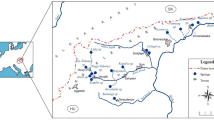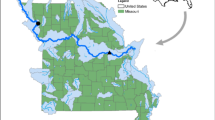Abstract
This paper attempted to identify fractal and chaotic characteristics of the annual runoff processes in headwaters of the Tarim River. Methods of fractal analyses were used to explore several aspects of the temporal changes from 1957 to 2002. The main findings are as follows: (1) The annual runoff processes of the three headwaters of the Tarim River are complex nonlinear systems with fractal as well as chaotic dynamics. (2) The correlation dimensions of attractor derived from the time series of the annual runoff for the Hotan, Yarkand and Aksu rivers are all greater than 3.0 and non-integral, implying that all three rivers are chaotic dynamical systems that are sensitive to initial conditions, and the dynamic modeling of their annual runoff process requires at least four independent variables. (3) The time series of annual runoff in each river presents a long-term correlation characteristic. The Hurst exponent for the period of 1989 to 2002 suggests that we may expect to see an increasing trend in the annual runoff of the Aksu and Yarkand rivers in the years after 2002, but a decreasing tendency for the Hotan River in the same period.
Similar content being viewed by others
References
Ai Nanshan, Li Houqiang, 1993. The nonlinear science methods for Quaternary studies. Quaternary Research, (2): 109–120. (in Chinese)
Comte F, Renault E, 1996. Long memory continuous time models. Journal of Econometrics, 73(1): 101–149.
Chen H, Guo S L, Xu C Y et al., 2007. Historical temporal trends of hydro-climatic variables and runoff response to climate variability and their relevance in water resource management in the Hanjiang basin. Journal of Hydrology, 344: 171–184.
Chen Y N, Xu Z X, 2005. Plausible impact of global climate change on water resources in the Tarim River Basin. Science in China (Series D), 48(1): 65–73.
Chen Y N, Zhang X L, Zhu X M et al., 2004. Analysis on the ecological benefits of the stream water conveyance to the dried-up river of the lower reaches of the Tarim River, China. Science in China (D), 47(11): 1053–1064.
Chen Y N, Takeuchi K, Xu C C et al., 2006. Regional climate change and its effects on river runoff in the Tarim Basin, China. Hydrological Processes, 20: 2207–2216.
Chen Y N, Li W H, Chen Y P et al., 2003. Water resources and ecological problems in Tarim River Basin, Xinjiang, China. In: Wilderer P A, Zhu J, Schwarzenbeck N (eds). Water and Environmental Management. London: IWA Publishing, 3–12.
Chen Ying, Deng Ziwang, Shi Hongzheng, 2006. Temporal change of annual runoff volume of the Aksu River, a source stream of the Tarim River. Arid Zone Research, 23(1): 21–25. (in Chinese)
Chou C M, 2007. Efficient nonlinear modeling of rainfall-runoff process using wavelet compression. Journal of Hydrology, 332: 442–455.
Fang C L, Bao C, Huang J C, 2007. Management implications to water resources constraint force on socio-economic system in rapid urbanization: A case study of the Hexi Corridor, NW China. Water Resource Management, 21: 1613–1633.
Gan T Y, 2000. Reducing vulnerability of water resources of Canadian Prairies to potential droughts and possible climate warming. Water Resources Management, 14(2): 111–135.
Grassberger P, Procacia I, 1983. Characterization of strange attractor. Physical Review Letters, 50(5): 346–349.
Hu C H, Hao Y H, Yeh T C J et al., 2008. Simulation of spring flows from a karst aquifer with an artificial neural network. Hydrological Processes, 22: 596–604.
Hurst H E, 1951.Long-term storage capacity of reservoirs. Transactions of American Society of Civil Engineers, 116: 770–808.
Hurst H E, Black R P, Simaike Y M, 1965. Long-term Storage: An Experimental Study. London: Constable
Lin X D, Zhang Y L, Yao Z J et al., 2008. The trend on runoff variations in the Lhasa River Basin. Journal of Geographical Sciences, 18(1): 95–106.
Liu Y B, Chen Y N, 2007. Saving the “Green Corridor”: Recharging groundwater to restore riparian forest along the lower Tarim River, China. Ecological Restoration, 25(2): 112–117.
Liu Y B, Corluy J, Bahremand A et al., 2006. Simulation of runoff and phosphorus transport in a carpathian catchment, Slovakia. River Research and Applications, 22(9): 1009–1022.
Mandelbrot B B, 1973. Formes nouvelles du hasard dans les sciences. Èconomie Appliqué, 26(2): 307–319. (in French)
Mandelbrot B B, Wallis J R, 1968. Noah, Joseph and operational hydrology. Water Resources Research, 4(5):909–918.
Movahed M S, Hermanis E, 2008. Fractal analysis of river flow fluctuations. Physica A: Statistical Mechanics and Its Applications, 387: 915–932.
Jiang Yan, Zhou Chenghu, Cheng Weiming, 2007. Streamflow trends and hydrological response to climatic change in Tarim headwater basin. Journal of Geographical Sciences, 17(1): 51–61.
Packard N H, Crutchfield J P, Farmer J F et al., 1980. Geometry from a time series. Physical Review Letters, 45:712–716.
Sivakumar B, 2007. Nonlinear determinism in river flow: Prediction as a possible indicator. Earth Surface Processes and Landforms, 32(7): 969–979.
Smith L C, Turcotte D L, Isacks B L, 1998. Streamflow characterization and feature detection using a discrete wavelet transform. Hydrological Processes, 12: 233–249.
Strupezewski W G, Singh V P, Weglarczyk S et al., 2006. Complementary aspects of linear flood routing modelling and flood frequency analysis. Hydrological Processes, 20: 3535–3554.
Wang W, Chen X, Shi P et al., 2008. Detecting changes in extreme precipitation and extreme streamflow in the Dongjiang River Basin in southern China. Hydrology and Earth System Sciences, 12: 207–221.
Wilcox B P, Seyfried M S, Matison T H, 1991. Searching for chaotic dynamics in snowmelt runoff. Water Resources Research, 27(6): 1005–1010.
Xia J, Zhang L, Liu C M et al., 2007. Towards better water security in north China. Water Resource Management, 21: 233–247.
Xu Jianhua, 2002. Mathematical Methods in Contemporary Geography. Beijing: Higher Education Press. (in Chinese)
Xu J H, Chen Y N, Li W H et al., 2008. Long-term trend and fractal of annual runoff process in mainstream of Tarim River. Chinese Geographical Science, 18(1): 77–84.
Xu J H, Lu Y, Su F L et al., 2004. R/S and wavelet analysis on the evolutionary process of regional economic disparity in China during the past 50 years. Chinese Geographical Science, 14(3): 193–201.
Zhang Xiaowei, Shen Bing, Huang Lingmei, 2007. Study on the variation law of the annual runoff in Hotan River. Journal of Natural Resources, 22(6): 974–979. (in Chinese)
Zhen Baolong, Shang Songhao, Tuerhong et al., 1998. Analys is of the dynamic trend of annual runoff of Yerqiang River. Irrigation and Drainage, 18(2): 7–9. (in Chinese)
Zhou X, Persaud N, Wang H, 2006. Scale invariance of daily runoff time series in agricultural. Hydrology and Earth System Sciences, 10: 79–91.
Author information
Authors and Affiliations
Corresponding author
Additional information
Foundation: Knowledge Innovation Project of CAS, No.KZCX2-XB2-03; Major Direction of Knowledge Innovation Project of CAS, No.KZCX2-YW-127; Shanghai Academic Discipline Project (Human Geography), No.B410
Author: Xu Jianhua (1965–), specialized in geographical quantitative methods and GIS.
Rights and permissions
About this article
Cite this article
Xu, J., Chen, Y., Li, W. et al. The complex nonlinear systems with fractal as well as chaotic dynamics of annual runoff processes in the three headwaters of the Tarim River. J. Geogr. Sci. 19, 25–35 (2009). https://doi.org/10.1007/s11442-009-0025-0
Received:
Accepted:
Published:
Issue Date:
DOI: https://doi.org/10.1007/s11442-009-0025-0




